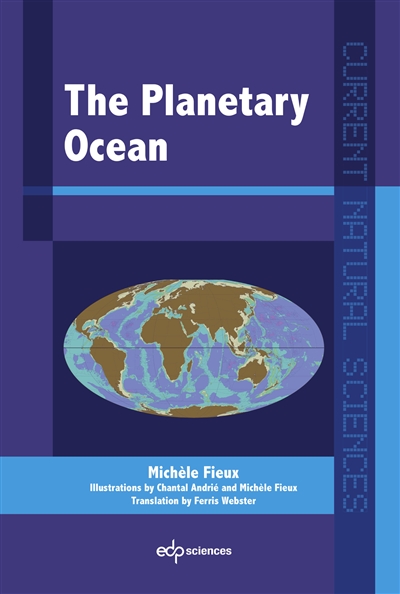
The planetary ocean
Résumé
Document d'initiation aux propriétés physiques de l'océan soulignant la spécificité de chaque bassin océanique. A travers une approche globale, avec un bref historique, il explique les interactions et le rôle de chaque étendue dans le fonctionnement de l'océan planétaire. ©Electre 2017

- Contributeur(s)
- Éditeur(s)
-
Date
- 2017
-
Notes
- En anglais
- Bibliogr. Glossaire. Index. Sites web
-
Langues
- Français
- , traduit de : Français
-
Description matérielle
- 1 vol. (XI-563 p.) : illustrations en noir et en couleur, cartes ; 23 x 16 cm
- Sujet(s)
-
ISBN
- 978-2-7598-2070-2
-
Indice
- 550.63 Océanographie générale, océanologie
-
Quatrième de couverture
-
The Planetary Ocean
The description of ocean water masses is based on the study of their temperature, salinity, and density, virtual genetic imprints which provide identity and movement to water masses. Ocean characteristics and processes involved in exchanges with the atmosphere together with simple dynamic balances give an understanding of a large part of the vast oceanic system.
This book is enhanced with numerous colored illustrations. It is a reference on regional oceanography updated with extensive results from the last twenty years. The presentation underscores the specificity of each ocean basin using a precise and global approach. Beginning with a brief historical context, it explains the interactions and the role of each ocean basin in the functioning of the planetary ocean. How do we recognize Antarctic Bottom Water in the middle of the Atlantic Ocean ? What is the densest water mass ? The warmest ? Why doesn't dense water form in the largest ocean basin ? What becomes of water that sinks in the Labrador Sea ? Why does the ocean play such an important role in climate variations ?... Answers can be found in this book.
Beyond a course in regional oceanography, the text is aimed at students in all fields of marine and environmental science as well as interested secondary school teachers. It also provides a guide to exploring the « ocean planet » that is comprehensible to any well-informed amateur eager to know the basics.
-
-
Tables des matières
-
The Planetary Ocean
Michèle Fieux
Current natural sciences
EDF Sciences
- Prolog1
- Preface to the French Edition3
- Acknowledgments5
- Introduction9
- I. Generalities
- 1 Ocean characteristics 15
- 1.1 Spatial characteristics15
- 1.2 Physical characteristics of pure water19
- 1.3 Chemical and physical properties of seawater20
- 2 Heat and water exchanges between ocean and atmosphere 25
- 2.1 Global radiation balance25
- 2.1.1 Incident solar radiation and albedo26
- 2.1.2 Absorption of incident radiation27
- 2.1.3 The greenhouse effect27
- 2.1.4 Long-wave (infrared) radiation27
- 2.1.5 Evaporation and conduction28
- 2.1.6 Radiative balance29
- 2.2 Distribution of ocean-atmosphere heat fluxes30
- 2.2.1 Solar radiation30
- 2.2.2 Heat loss by infrared radiation31
- 2.2.3 Heat loss by evaporation32
- 2.2.4 Heat loss by conduction32
- 2.2.5 Net heat flux34
- 2.3 Atmosphere and ocean heat transport35
- 2.4 Ocean surface temperature37
- 2.5 Water fluxes39
- 2.5.1 Evaporation and precipitation39
- 2.5.2 Water flux balance42
- 2.6 Surface salinity42
- 2.7 Surface density43
- 2.8 Heat and salt transfers to the ocean interior. The thermocline44
- 3 Water masses 51
- 3.1 General properties of water masses51
- 3.2 Mode Waters, Central Waters, and Intermediate Waters52
- 3.3 Bottom Waters and Deep Waters55
- 3.4 Analysis of water characteristics56
- 3.4.1 Potential temperature and potential density57
- 3.4.2 Potential temperature-salinity diagram58
- 3.4.3 Tracers62
- 4 Ocean circulation 65
- 4.1 Laws controlling oceanic motion65
- 4.2 The effect of Earth rotation on motion, the Coriolis force66
- 4.3 Geostrophy : the principal balance of forces in the ocean70
- 4.4 The dynamic method74
- 4.5 Dynamic topography77
- 4.6 Thermohaline circulation78
- 5 The role of wind 81
- 5.1 Oceanic and atmospheric surface circulation81
- 5.2 Local wind effects : Ekman transport85
- 5.2.1 Wind acting near a coastline : coastal upwelling89
- 5.2.2 Wind at the equator : equatorial upwelling, Equatorial Undercurrent91
- 5.3 Large-scale wind effects93
- 5.3.1 Ekman pumping93
- 5.3.2 Sverdrup balance98
- 5.3.3 Western intensification of ocean currents100
- 5.3.4 Conservation of potential vorticity102
- 6 Observational techniques 105
- 6.1 Temperature and salinity measurements105
- 6.1.1 Reversing thermometers105
- 6.1.2 Bathythermograph107
- 6.1.3 Expendable bathythermograph, or XBT108
- 6.1.4 Salinometer110
- 6.1.5 Thermosalinograph110
- 6.2 The hydrographic station and its measurements110
- 6.2.1 Knudsen, Nansen, and Niskin sample bottles111
- 6.2.2 CTD probe and rosette112
- 6.3 Direct current measurements117
- 6.3.1 Current meters117
- 6.3.2 Acoustic Doppler current profilers119
- 6.3.3 Moored current meters122
- 6.3.4 Surface-moored buoy126
- 6.4 Drifting buoys, floats, profilers, gliders127
- 6.4.1 Drifting buoys127
- 6.4.2 Swallow floats and SOFAR floats129
- 6.4.3 Profiling floats130
- 6.4.4 Gliders131
- 6.4.5 Animal-borne instruments : How elephant seals can help exploring the ocean132
- 6.5 Satellite measurements134
- II. The Antarctic (or Austral) Ocean
- 1 Introduction 139
- 2 Geographic characteristics 145
- 3 Atmospheric pressure and winds 151
- 4 Climatology 155
- 4.1 Glaciers and ice pack155
- 4.1.1 Continental glaciers, ice shelves155
- 4.1.2 The ice pack157
- 4.1.3 Polynyas159
- 4.2 Precipitation161
- 5 Surface circulation 163
- 5.1 The Antarctic Circumpolar Current163
- 5.2 The Antarctic Circumpolar Current and oceanic fronts167
- 5.2.1 The Subtropical Front and the Subantarctic Zone169
- 5.2.2 The Subantarctic Front and the Polar Frontal Zone170
- 5.2.3 The Polar Front, the Antarctic Zone, and the Southern Antarctic Circumpolar Current Front172
- 5.2.4 The Southern Zone, the Southern Boundary and the Antarctic Divergence172
- 5.2.5 The role of topography in the Circumpolar Current173
- 5.3 The Periantarctic Coastal Current174
- 6 Water properties 177
- 6.1 Surface temperature177
- 6.2 Salinity177
- 6.3 Antarctic Ocean Water Masses180
- 6.3.1 Antarctic Circumpolar Deep Water184
- 6.3.2 Antarctic Intermediate Water and Subantarctic Mode Water189
- 6.3.3 Bottom Water and Deep Water in the Weddell Sea191
- 6.3.4 Antarctic Bottom Water195
- 7 Distinctive features of the Antarctic Ocean 201
- III. The Atlantic Ocean
- 1 Introduction 205
- 2 Geographic characteristics 209
- 3 Climatology 213
- 3.1 Pressure and winds213
- 3.2 Precipitation and evaporation216
- 4 Surface and subsurface circulation 219
- 4.1 The equatorial current system220
- 4.1.1 The North Equatorial Current221
- 4.1.2 The South Equatorial Current and the North Brazil Current223
- 4.1.3 North Equatorial Countercurrent224
- 4.1.4 South Equatorial Countercurrent and the Angola Dome226
- 4.1.5 The Equatorial Undercurrent227
- 4.1.6 North and South Equatorial undercurrents231
- 4.1.7 Equatorial jets231
- 4.2 The North subtropical gyre232
- 4.2.1 The Gulf Stream system232
- 4.2.1.1 Circulation in the American Mediterranean235
- 4.2.1.2 The Florida Current236
- 4.2.1.3 The Gulf Stream238
- 4.2.2 The North Atlantic Drift and eastern boundary currents245
- 4.3 The subpolar cycolnic gyre246
- 4.4 The south subtropical gyre247
- 4.5 Upwelling zones249
- 4.5.1 Equatorial upwelling249
- 4.5.2 Canary upwelling249
- 4.5.3 Benguela upwelling250
- 5 Adjacent seas 253
- 5.1 The (Eurafrican) Mediterranean253
- 5.1.1 Introduction253
- 5.1.2 Topography254
- 5.1.3 Climatology256
- 5.1.4 Surface circulation259
- 5.1.5 Mediterranean oceanography261
- 5.1.5.1 Atlantic Water261
- 5.1.5.2 The Black Sea263
- 5.1.5.3 Formation processes of Mediterranean water masses265
- 5.1.5.4 Intermediate Levantine Water265
- 5.1.5.5 Aegean Sea266
- 5.1.5.6 Adriatic Sea and Eastern Basin Deep Water267
- 5.1.5.7 Western Basin Deep Water269
- 5.1.5.8 Mediterranean characteristics275
- 5.2 The Arctic Ocean, the Norwegian Sea, and the Greenland Sea (or Arctic Mediterranean)275
- 5.2.1 Introduction275
- 5.2.2 Topography277
- 5.2.3 Climatology280
- 5.2.3.1 Pressure and winds280
- 5.2.3.2 Precipitation and heat flux281
- 5.2.4 Surface currents of the Arctic Ocean283
- 5.2.5 Surface temperature288
- 5.2.6 Arctic Mediterranean Oceanography289
- 5.2.6.1 Atlantic Water289
- 5.2.6.2 Arctic Surface Water293
- 5.2.6.3 Deep Water of the Greenland Sea and of the Norwegian Sea294
- 5.2.6.4 Arctic Deep Water298
- 5.2.6.5 Arctic Intermediate Waters300
- 5.2.6.6 Overflows from the Nordic Seas301
- 6 Water properties 303
- 6.1 Surface water304
- 6.2 Subtropical Waters, Central Waters, Subtropical Mode Waters307
- 6.2.1 North and South Subtropical Waters307
- 6.2.2 North and South Central Waters308
- 6.3 Antarctic Intermediate Water310
- 6.4 Arctic Intermediate Waters and Subpolar Mode Waters311
- 6.5 Mediterranean Water314
- 6.6 Antarctic Bottom Water314
- 6.7 Dense waters exiting over the Greenland-Scotland sills318
- 6.7.1 Sill Water between Iceland and Scotland318
- 6.7.2 Denmark Water Strait319
- 6.8 Labrador Sea Water322
- 6.9 North Atlantic Deep Water326
- 7 Water properties of adjacent and epicontinental seas 333
- 7.1 American Mediterranean (Caribbean Sea)333
- 7.2 Some epicontinental seas334
- 7.2.1 The North Sea334
- 7.2.2 The Baltic Sea335
- 7.2.3 Hudson Bay336
- 7.2.4 Baffin Bay337
- 8 Distinctive features of the Atlantic Ocean 339
- IV. The Indian Ocean
- 1 Introduction 343
- 2 Geographic characteristics 345
- 3 Climatology 349
- 3.1 Atmospheric pressure and wind regime349
- 3.1.1 Pressure and winds over the southern Indian Ocean349
- 3.1.2 Pressures and winds over the northern Indian Ocean351
- 3.2 Precipitation, evaporation, heat exchange353
- 4 Surface circulation 357
- 4.1 General circulation357
- 4.2 Circulation South of 10°S358
- 4.2.1 South Equatorial Current358
- 4.2.2 SE and NE Madagascar Currents359
- 4.2.3 Agulhas Current360
- 4.2.4 South Indian Current, West Australian Current and the eastern cyclonic circuit361
- 4.2.5 Leeuwin Current362
- 4.2.6 Upper connections with the Pacific and the Atlantic Oceans364
- 4.3 Circulation North of 10°S364
- 4.3.1 Circulation in the Arabian Sea and along the Somali coast364
- 4.3.2 Circulationp in the Bay of Bengal and the eastern Indian Ocean371
- 4.3.3 Equatorial Current, Wyrtki Jet372
- 4.3.4 South Equatorial Countercurrent375
- 4.3.5 Equatorial Undercurrent376
- 5 Water properties 379
- 5.1 Surface water379
- 5.1.1 Surface temperature379
- 5.1.2 Surface salinity381
- 5.2 Adjacent seas382
- 5.2.1 The Red Sea382
- 5.2.2 The Persian Gulf389
- 5.2.3 Indonesian Seas393
- 5.3 Indian Ocean Water Masses402
- 5.3.1 Antarctic Intermediate Water and Subantarctic Mode Waters402
- 5.3.2 South Indian Ocean Central Water, Subtropical Mode Waters, South Indian Ocean Subtropical Water404
- 5.3.3 The Hydrologic Front407
- 5.3.4 Arabian Sea Water, Northwest Indian Ocean Water410
- 5.3.5 Bay of Bengal Water413
- 5.3.6 Indian Deep Water414
- 5.3.7 Indian Ocean Bottom Water415
- 6 Distinctive features of the Indian Ocean 419
- V. The Pacific Ocean
- 1. Introduction 423
- 2 Geographic characteristics 425
- 3 Climatology 429
- 3.1 Pressure distribution429
- 3.2 Winds431
- 3.3 Precipitation, evaporation, and heat exchanges432
- 3.4 Climatic anomalies over the Pacific : El Niño434
- 4 Surface circulation 439
- 4.1 General circulation439
- 4.2 Equatorial current systems440
- 4.2.1 The North Equatorial Current441
- 4.2.2 The South Equatorial Current441
- 4.2.3 The North Equatorial Countercurrent443
- 4.2.4 The South Equatorial Countercurrent444
- 4.2.5 The Equatorial Undercurrent444
- 4.2.6 The Equatorial Intermediate Current and equatorial jets449
- 4.2.7 The North Equatorial Undercurrent and the South Equatorial Undercurrent450
- 4.2.8 Equatorial upwelling451
- 4.2.9 Instabilities452
- 4.2.10 Variability452
- 4.3 Western boundary currents453
- 4.3.1 The Kuroshio453
- 4.3.2 The subpolar cyclonic circuit and the Oyashio456
- 4.3.3 The Mindanao Current and the New Guinea Coastal Current458
- 4.3.4 The East Australian Current460
- 4.4 Eastern boundary currents and coastal upwelling461
- 4.4.1 Peruvian upwelling461
- 4.4.2 California upwelling462
- 4.5 The South Pacific Current463
- 5 Water properties 465
- 5.1 Surface water465
- 5.1.1 Surface temperature465
- 5.1.2 Surface salinity466
- 5.2 Subtropical salinity maximum, North and South Tropical Waters467
- 5.3 Central and Equatorial Waters468
- 5.3.1 Southwest and Southeast Pacific Central Waters469
- 5.3.2 Northwest and Northeast Pacific Central Waters469
- 5.3.3 North and South Pacific Equatorial Waters470
- 5.4 Intermediate Waters472
- 5.4.1 Antarctic Intermediate Water473
- 5.4.2 Subarctic Water and North Pacific Intermediate Water475
- 5.5 Deep Water and Bottom Water477
- 5.6 Some Pacific Ocean Adjacent Seas483
- 5.6.1 The Sea of Japan483
- 5.6.2 The Bering Sea487
- 5.6.3 The Sea of Okhotsk490
- 6 Distinctive features of the Pacific Ocean 493
- VI. Conclusions
- 1 Planetary ocean water properties 497
- 1.1 Temperature and salinity distribution499
- 1.2 The ensemble of (...) diagrams500
- 1.3 Specific featurees of each ocean500
- 2 Circulation of the planetary ocean 505
- 3 Thoughts on ocean variability, climatic implications 511
- 3.1 Oceanic response to global atmospheric warming511
- 3.2 Examples of interannual variability512
- 3.3 In the form of an epilog514
- References, acronyms, web sites515
- Index553
-
-
Origine de la notice:
- Electre
-
Disponible - 550.63 FIE
Niveau 2 - Sciences





















